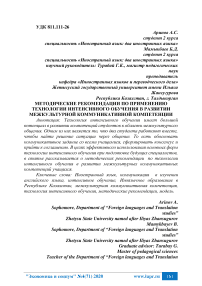Methodological guidelines for accelerated learning technology in the development of intercultural communicative competencies
Автор: Arinov A., Mamykbayev B.
Журнал: Экономика и социум @ekonomika-socium
Рубрика: Основной раздел
Статья в выпуске: 4 (71), 2020 года.
Бесплатный доступ
Accelerated learning technology has great potential in developing students' competencies in intercultural communication. One of them is that two students work together to find a solution to the situation through communication. That is, to justify the communicative task with all students, build consensus and come to an agreement. In order to effectively use the basic forms of accelerated learning technology in the training of future specialists, the article describes the guidelines for accelerated learning technology in the development of intercultural communicative competencies of students.
Foreign language, foreign language education of republic of kazakhstan, intercultural communicative competence, methodological guidelines, model, communication
Короткий адрес: https://sciup.org/140253078
IDR: 140253078
Список литературы Methodological guidelines for accelerated learning technology in the development of intercultural communicative competencies
- Denisova, L.G. Mesto intensivnoj metodiki v sisteme obucheniya inostrannym yazykam v srednej shkole/ L.G. Denisova // Inostrannye yazyki v shkole. -1995. -№4. -S. 6-12
- Gegechkori L.K. K probleme intensifikacii processa obucheniya vzroslyh inoyazychnoj rechi/ L. Gegechkori. - Tbilisi: Izd. Tbilisskogo universiteta, -1975. - 297s.
- Kitajgorodskaya G.A. Intensivnoe obuchenie inostrannym yazykam: teoriya i praktika: Uchebno-metodicheskoe posobie - M.: Vysshaya shkola; Nauchnoobrazovatel'nyj centr "SHkola Kitajgorodskoj", 2009. -277s.
- Kunanbaeva S.S. Kazirgi shettildik bilim berudin teoriyasy men praktikasy.: - Almaty, -2009. -S. -29
- Schukin A.N. Obuchenie inostrannym yazykam: Teoriya i praktika: Uchebnoe posobie dlya prepodavatelej i studentov. 2-e izd., ispr. i dop. 2006. S. 48-56


